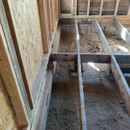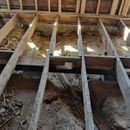Vapor Barrier Thickness for Encapsulated Crawlspace
I am going to encapsulate the crawlspace. There is so much guidance on the best way to do a crawlspace that will in effect be a “crawlspace” what about one that will have zero activity once enclosed?
I’d like to mix the products to reduce some costs due to this. Can I just use 10mil poly in the areas that will never be crawled in once the floor is back in place? (I am replacing subfloor and leveling the joists) I will use a reinforced in the areas where plumbing runs for future service.
The clearance for the entire crawlspace is only 8″ except for the area where DW pipe is running which is dug deeper. I would use reinforced in that area to protect in case it needs to be accessed. Water lines will also run in the same area.
The space will be smooth dirt under the barrier, all debris removed.
Does this make sense? Any reason I should save a few hundred dollars?
GBA Detail Library
A collection of one thousand construction details organized by climate and house part











Replies
Until you can change your language it seems to me your project is all but doomed to fail.
So long is you keep using the word encapsulate that implies you want to keep the crawl space separated both from the interior and the exterior of your home, what you are building does not comply with the code and is likely to become s mold factory.
Only after you can bring yourself to call it a conditioned crawlspace will you be able to bring yourself to install and operate the equipment necessary to keep the crawlspace at more or less the same temp and humidity as the rest of your home keeping it dry and mold free.
If you are planning on venting or conditioning the crawlspace and want a ground vapor barrier, I say you want the largest unbroken layer of plastic possible from high on each wall covering everything in between.
Walta
Walta,
Encapsulation today means a closed or non-vented crawl space. The way this term is used today means that the crawl space will become a part of the conditioned space of the house.
I appreciate your answer but was looking for a specific response related to the thickness of the vapor barrier.
Thanks
Ron
ronny2b,
Yes, there is no advantage to using thicker poly in areas where it will not be susceptible to mechanical damage.
Thanks Malcom, that's what I thought and appreciate the confirmation.
That area basically looks inaccessible after your floor goes down so I doubt you'll have much crawling around down there or be using it for storage.
I have crawled around in my crawlspace a lot and regret only going with 6 mil. Its gotten a little chewed up in a few areas and had to be repaired. Our local green building program recommends going with a minimum of 10 mils. 6 might be just fine for you though.
Code minimum is 6 mil, but I'd never go that light on the floor since it's too easy to damage. I look at 10 mil as a minimum, and 20 mil if there will be access for maintenance or storage (although storing stuff in a crawl space is always asking for trouble).
What I like to do is use 6 mil on the walls and 20 mil on the floor. This is a good way to save some money without really compromising the system. What you need to do before planning to use two thicknesses is to figure out how much material you need for the walls and the floor as seperate areas, then look at the mimimum sizes sold by the crawlspace liner companies. Sometimes there is little actual savings to using two thicknesses after you add in the cost for the tape and the wasted material if the roll sizes don't work out for your particular space. You want the cheapest overall materials cost, but also remember that the more cutting and taping you do, the more labor goes into the job, and it's less labor to use all one thickness and minimize the taping you do.
The easiest way I've found to cost out the materials is to work out the area of the floor, then compare that to the available roll sizes for the thickness of liner you want to use on the floor. Now work out the area of the walls, and find the closest size roll of liner for that part. If you can get a large enough roll of "floor" liner to also go up the walls for less money than the extra roll of "wall" liner, then just use the floor liner everywhere since it's cheaper overall. Keep in mind that the seaming tape is fairly expensive per roll too, so that's something else to consider. It doesn't hurt to use thicker than required liner on the walls, so it's really just a matter of keeping costs under control there.
From the pic you posted, I'd probably just use 10 or 12 mil everywhere and be done with it. I doubt you'll be doing much work down there since it looks really low clearance, so this is probably a one-time project that you'll never see again. You have very short walls, so I'd not try to save money on the walls since I don't think the materials savings would be enough to justify the extra labor. I'd use 10 mil (or 12 mil, some vendors have similar pricing for those two thicknesses) everywhere so that you have only one roll and keep taping to a minimum. I'd avoid 6 mil simply because it's too easy to damage during installation or if you drop something on it while you're putting your floor back together.
Bill
ronny2b,
would it make sense to you to take the floor joists out for a moment so that you can run a continoous vapor barier and then reinstall the joists?
What you have is a patchwork..
regards - Bas
Continuity isn't important in vapour barrier, nor are a few incidental holes. You can overlap the edges and tape if necessary.
The only reason to avoid cutting and taping is to cut down on the labor required. Sometimes it's easier to cut sections and tape them in place. If you can't easily get a full-size roll into a crawlspace, I'd cut more manageable size pieces outside of the crawlspace and tape them together after laying them out on the crawlspace floor or wall. As Malcolm mentioned, seams aren't a big deal in terms of the integrity of the vapor barrier as long as you use the right tape (one that stays stuck to polyethylene). A few holes aren't usually a huge problem, but I try to avoid holes since they are places where tears can start, and large tears are a problem.
Bill
If you have or plan to have mechanical ventilation, such as an HRV, running a supply and return into the crawl will greatly improve air quality. Radon levels will also be reduced, if present. It is a low tech, low cost way to improve a crawl space.
I like the handling ability of the heavier mil plastics, because I think they're easier to lay out and cut/seam/tape. Light mil films can get frustrating. Durability doesn't sound like an issue though, so strike a balance between ease of install and adequate durability. The 10-12mil range mentioned above sounds like a good blend.
Are you in an area with elevated radon levels? If so, it is important to seal the vapor retarder seams, and from what I understand, thicker membranes may do a better job of blocking radon gas. But I don't have a source that proves that claim. I typically spec 10-mil vapor retarders when they won't be walked on directly, and 15+ mil when they will be walked on.